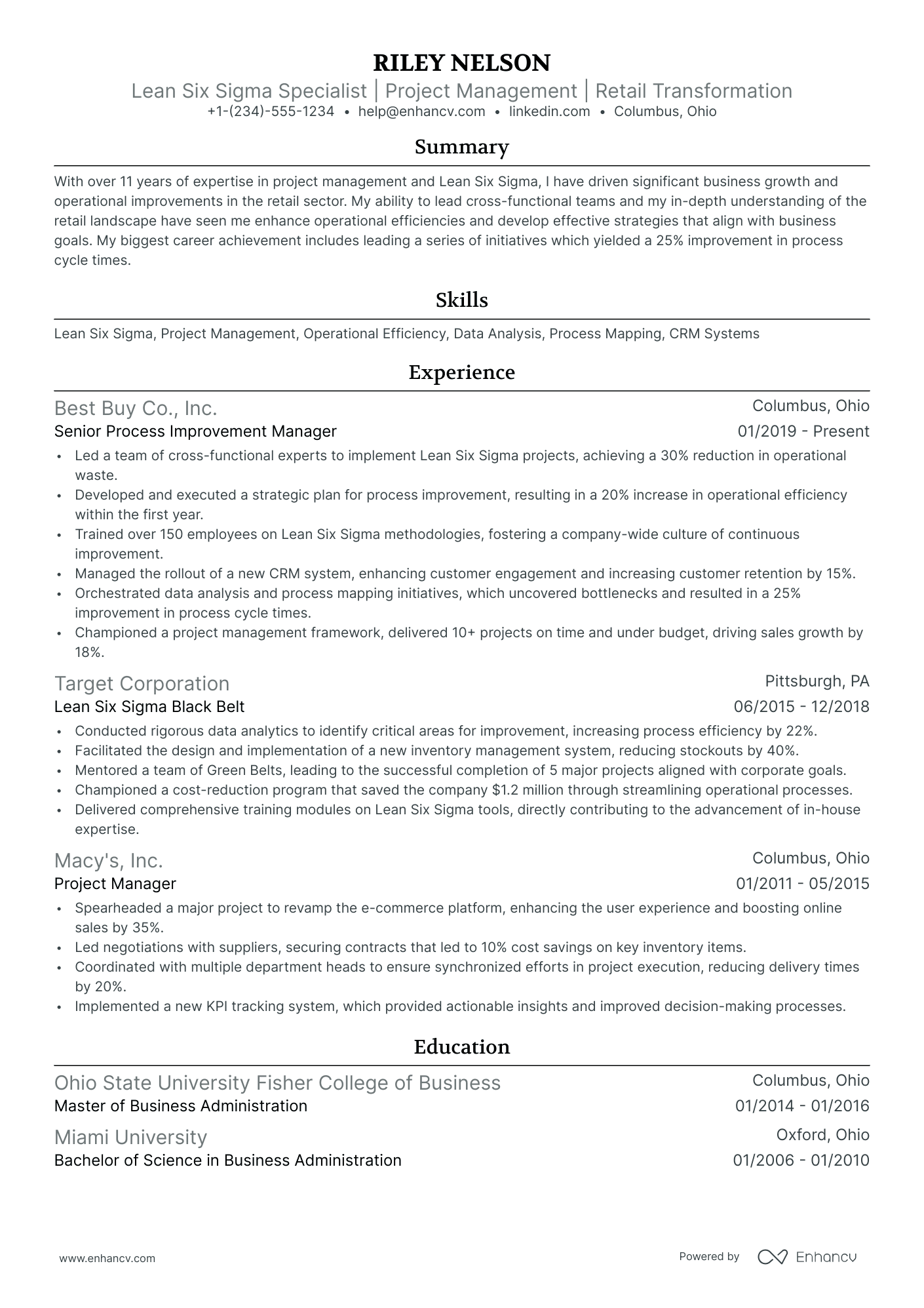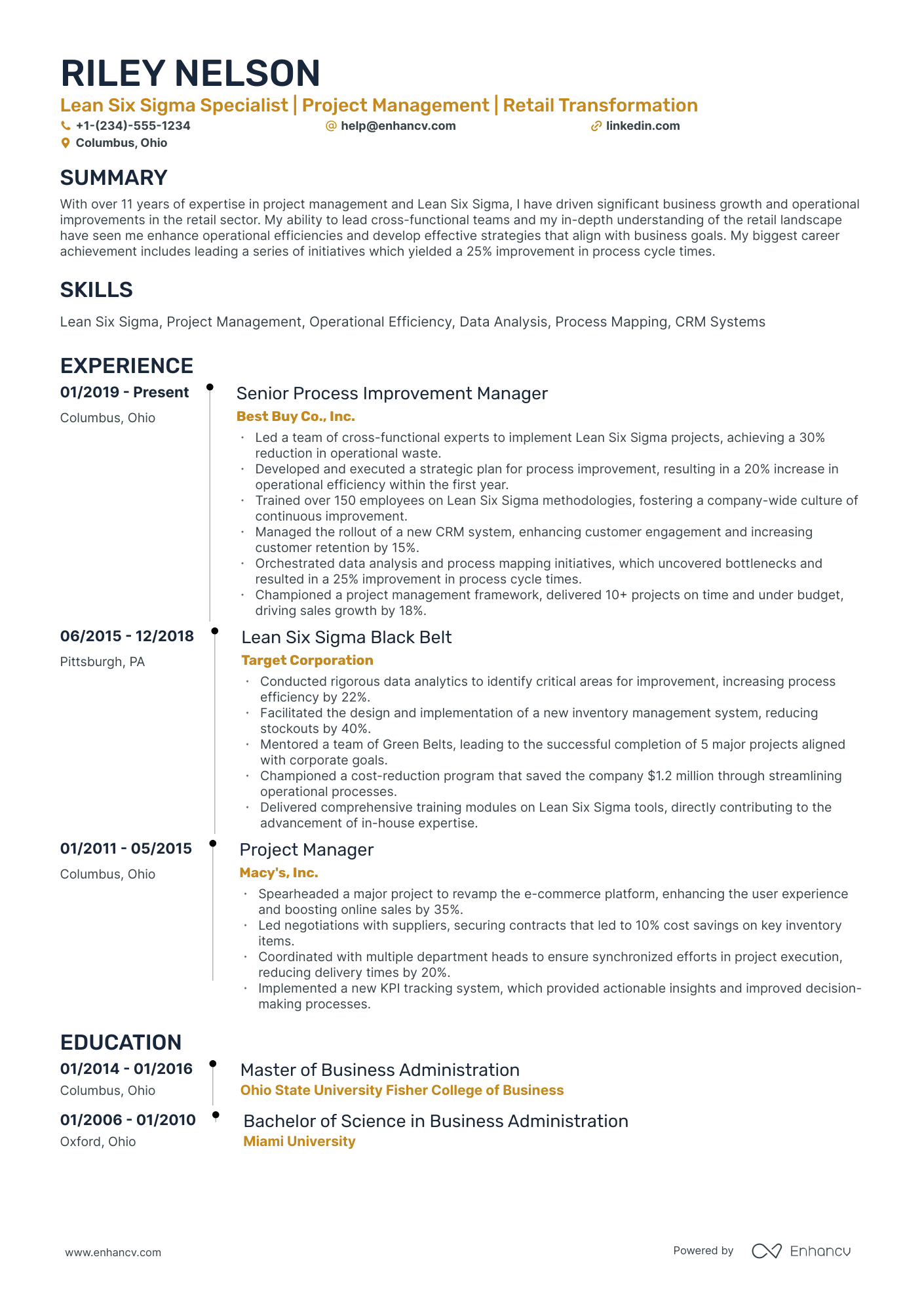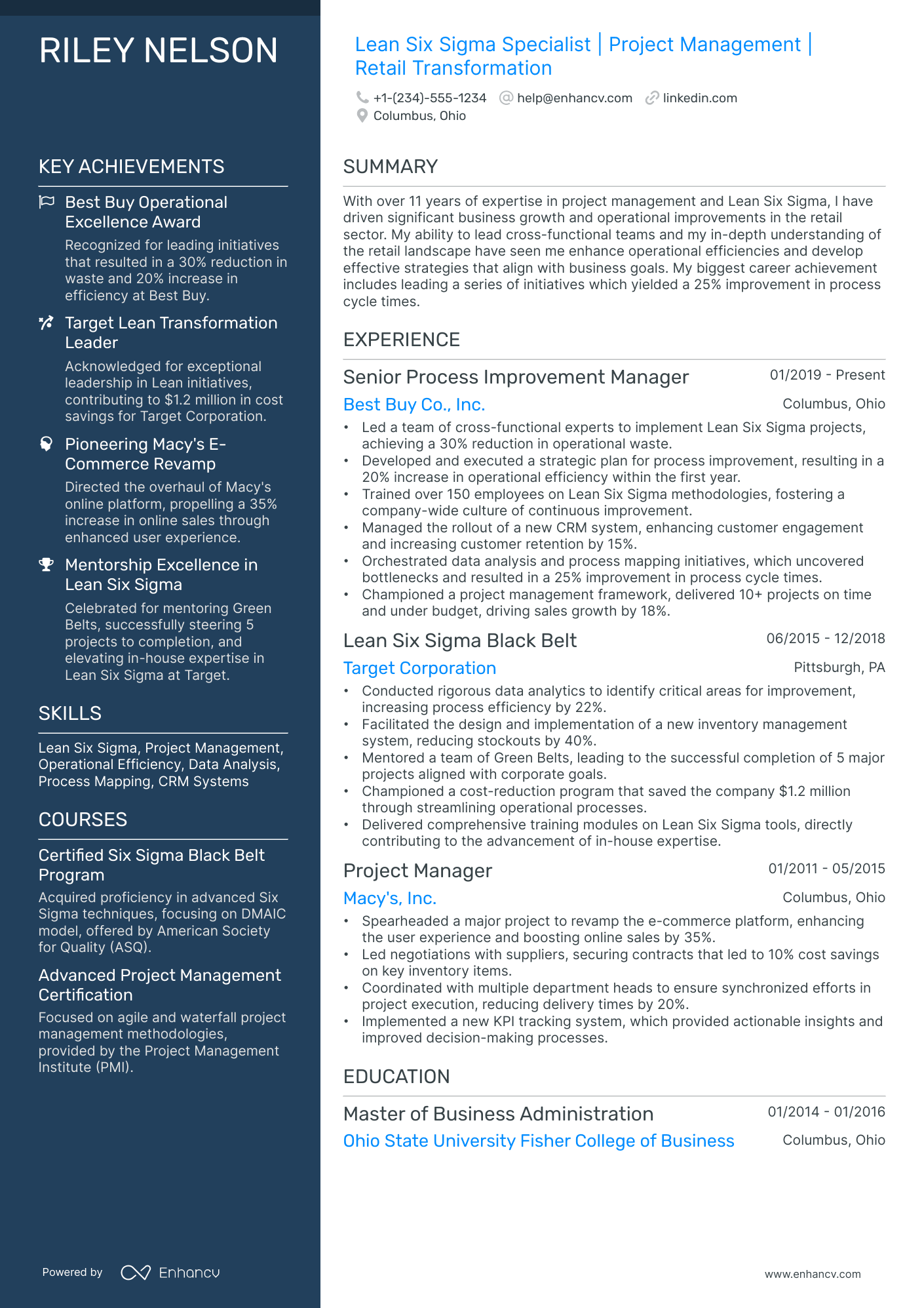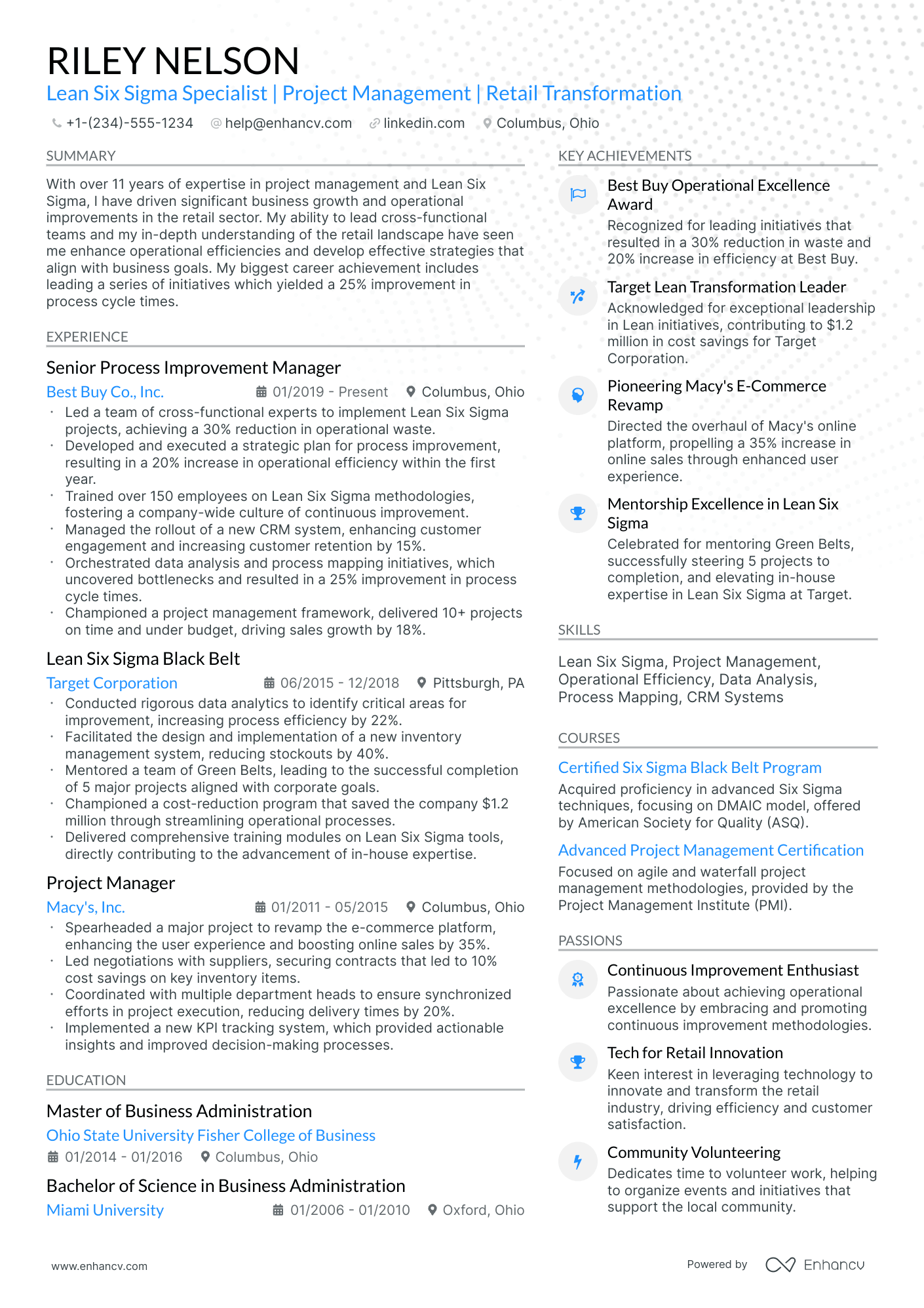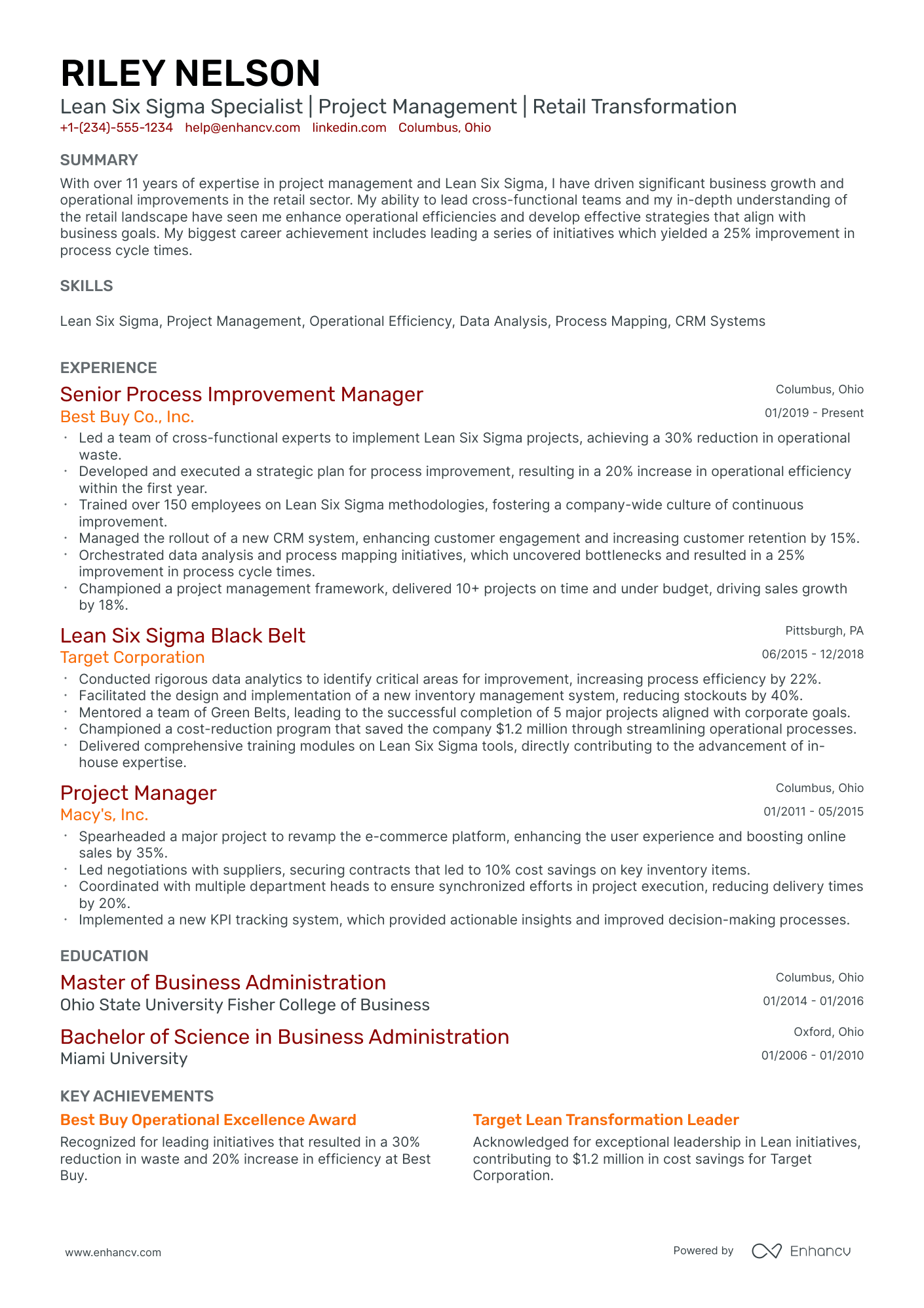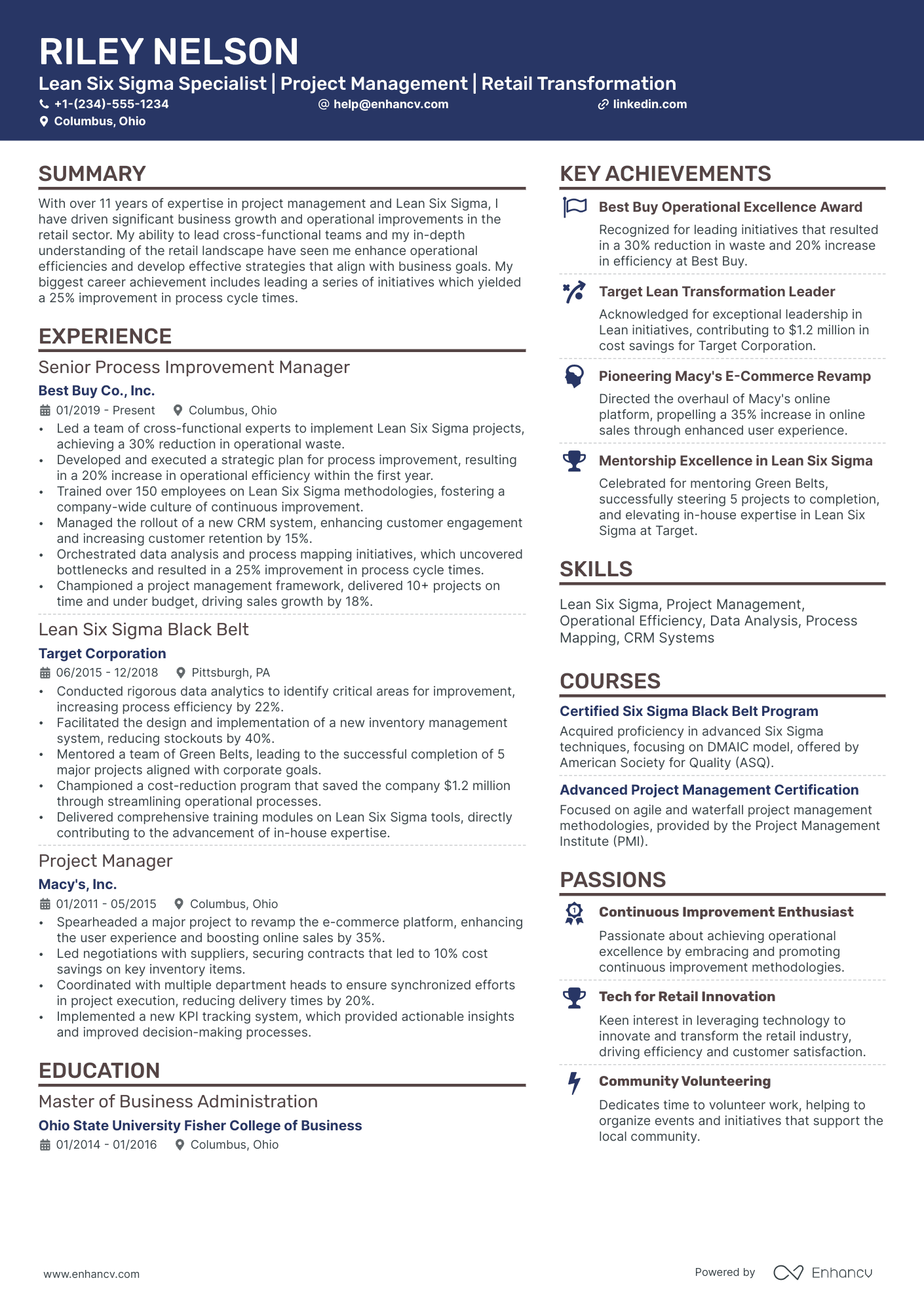One specific resume challenge you may encounter as a six sigma professional is effectively showcasing your process improvement achievements without overwhelming the employer with technical jargon. Our guide can assist you in translating your complex six sigma projects into compelling and understandable bullet points that will catch a recruiter's attention.
- Aligning the top one-third of your six sigma resume with the role you're applying for.
- Curating your specific six sigma experience to get the attention of recruiters.
- How to list your relevant education to impress hiring managers recruiting for the six sigma role.
Discover more six sigma professional examples to help you write a job-winning resume.
- Microsoft Program Manager Resume Example
- Salesforce Project Manager Resume Example
- Marketing Product Manager Resume Example
- Nonprofit Program Manager Resume Example
- Assistant Product Manager Resume Example
- Project Coordinator Resume Example
- Product Development Manager Resume Example
- Agile Project Manager Resume Example
- Digital Project Manager Resume Example
- Process Engineer Resume Example
Optimize your six Sigma resume format to pass the recruiters' assessment
You may be wondering just how much time you need to spend on designing your six sigma resume.
What recruiters are looking for is systematised content that is clear and coherent. Thus, your six sigma resume needs to answer requirements and why you're the best candidate for the role from the get-go.
Often, a clear layout consists of:
- Sorting your experience in the reverse chronological order - starting with your most recent and relevant roles. This is an excellent choice for more experienced professionals;
- Writing your contact information (e.g. personal phone number and email address) and your portfolio or LinkedIn link in your six sigma resume header. If you're wondering to include a photo or not, always make sure that it's appropriate for the country you're applying in;
- Use the basic, most important six sigma resume sections - your experience, education, summary, etc. Use your resume's real estate wisely to tell a compelling, professional story and match job description's keywords;
- Don't go overboard with the length of your resume. One page is absolutely fine if you happen to have under a decade of relevant experience.
Are you still wondering if you should submit your six sigma resume in PDF or Word format ? The PDF has a few more advantages, as it doesn't change the format and the text can't be altered upon application.
Format matters most when your six sigma resume is assessed by the Applicant Tracker System (or the ATS).
The ATS parses resumes, looking for specific keywords, skills or experience that match the job description.
P.S. We recently did a study on how the ATS works and were able to demystify three of the biggest misconceptions about how it assesses candidate resumes.
To pass the ATS evaluation, select any of the serif or sans-serif fonts. Popular choices that would help your six sigma resume stand out include Raleway, Exo 2, Montserrat, etc.
Most traditionalists go for Arial or Times New Roman, but it's often the case that many candidates choose these fonts, and you'd thus lose points on the uniqueness front.
Each market has its own resume standards – a Canadian resume layout may differ, for example.
Upload & Check Your Resume
Drop your resume here or choose a file. PDF & DOCX only. Max 2MB file size.
PRO TIP
The more time and effort you've put into obtaining the relevant certificate, the closer to the top it should be listed. This is especially important for more senior roles and if the company you're applying for is more forward-facing.
The six in-demand sections for your six sigma resume:
- Top one-third should be filled with a header, listing your contact details, and with a summary or objective, briefly highlighting your professional accolades
- Experience section, detailing how particular jobs have helped your professional growth
- Notable achievements that tie in your hard or soft skills with tangible outcomes
- Popular industry certificates to further highlight your technical knowledge or people capabilities
- Education to showcase your academic background in the field
What recruiters want to see on your resume:
- Lean six sigma certification levels (Yellow Belt, Green Belt, Black Belt, Master Black Belt).
- Quantifiable achievements related to process improvements, cost savings, or increases in efficiency.
- Experience with specific six sigma tools and methodologies (e.g., DMAIC, DMADV, Value Stream Mapping).
- Knowledge of statistical analysis software (e.g., Minitab, JMP, R) and proficiency in data analysis.
- Experience in leading and facilitating six sigma projects and cross-functional teams.
Advice for your six Sigma resume experience section - setting your application apart from other candidates
Your resume experience section needs to balance your tangible workplace achievements with job requirements.
The easiest way to sustain this balance between meeting candidate expectations, while standing out, is to:
- Select really impressive career highlights to detail under each experience and support those with your skills;
- Assess the job advert to define both the basic requirements (which you could answer with more junior roles) and the more advanced requirements - which could play a more prominent role through your experience section;
- Create a separate experience section, if you decide on listing irrelevant experience items. Always curate those via the people or technical skills you've attained that match the current job you're applying for;
- Don't list experience items from a decade ago - as they may no longer be relevant to the industry. That is, unless you're applying for a more senior role: where experience would go to demonstrate your character and ambitions;
- Define how your role has helped make the team, department, or company better. Support this with your skill set and the initial challenge you were able to solve.
Take a look at how real-life six sigma professionals have presented their resume experience section - always aiming to demonstrate their success.
- Led a cross-functional team to identify and eliminate waste in the production process, achieving a 22% reduction in material costs.
- Designed and implemented a Six Sigma-based quality control system, increasing product reliability by 35% and customer satisfaction by 40%.
- Facilitated over 30 Kaizen workshops, resulting in process enhancements that led to a 25% improvement in cycle time efficiency.
- Orchestrated a company-wide Lean Six Sigma initiative that reduced manufacturing defects by 27%, saving the company approximately $1.8 million annually.
- Collaborated with R&D to integrate Six Sigma principles in product design, shortening development cycles by 18% and strengthening product-market fit.
- Conducted in-depth statistical analysis to optimize supply chain logistics, resulting in a 15% boost in on-time delivery rates.
- Drastically improved operational efficiency through the deployment of DMAIC and DMADV methodologies, leading to a sustained increase in EBITDA margins by 10%.
- Mentored and trained over 200 employees in Lean Six Sigma principles, building a robust culture of continuous improvement.
- Pioneer of a proprietary Six Sigma analytics tool that forecasted process breakdowns with 90% accuracy, enabling proactive maintenance.
- Streamlined production processes through advanced Six Sigma methodologies, cutting down manufacturing lead times by an average of 16 days.
- Implemented strategic process control plans that enhanced overall product quality and led to a 5-star customer rating across key product lines.
- Managed a portfolio of Six Sigma projects with a combined budget of $5 million, ensuring all projects were delivered under budget and ahead of schedule.
- Executed a strategic performance analysis, identifying bottlenecks that were impeding workflow and implemented remedial measures to enhance throughput by 20%.
- Championed a Six Sigma training program that certified 120 team members as Green Belts, fostering a knowledgeable and versatile workforce.
- Optimized inventory management using Six Sigma tools, trimming excess inventory by 30% and reducing storage costs significantly.
- Spearheaded the integration of Six Sigma methodologies into software development lifecycle, which precipitated a 45% improvement in code efficiency.
- Led a high-impact Six Sigma project that resolved product shipping errors, ultimately boosting delivery accuracy by over 50% and enhancing customer retention rates.
- Partnered with IT to develop a data-driven Six Sigma tracking system, providing real-time project performance metrics and influencing strategic decisions.
- Drove significant cost reductions by identifying inefficiencies in the procurement process, resulting in annual savings of $2 million.
- Initiated a Six Sigma project that standardized vendor selection criteria, leading to improved vendor performance and product quality.
- Introduced robust problem-solving techniques which led to a 98% on-time completion rate of Six Sigma projects, contributing to overall corporate goals.
- Devised and executed a Six Sigma training curriculum as part of talent development initiatives, certifying over 150 employees as Six Sigma practitioners.
- Applied Six Sigma tools to revamp customer service protocols, which drastically cut down response times by 30% and increased customer satisfaction scores.
- Led a cross-departmental Six Sigma project to overhaul IT systems, enhancing system reliability while reducing unplanned downtime by 40%.
Quantifying impact on your resume
- Detail the percentage decrease in project cycle times achieved through six sigma methodologies to highlight efficiency gains.
- Quantify the cost savings delivered to the business by implementing process improvements to demonstrate financial impact.
- Specify the increase in customer satisfaction scores as a result of six sigma projects to show customer-centric outcomes.
- Document the number of six sigma projects led or participated in to indicate experience and leadership.
- Mention any reduction in waste or increase in process capability by listing statistical measures such as sigma level improvement.
- Report the revenue growth experienced by the company from six sigma initiatives to emphasize top-line impact.
- Enumerate the number of processes standardized or streamlined through six sigma approaches to present organizational influence.
- Cite any certifications or levels achieved in the six sigma methodology to establish expertise and commitment to quality.
Action verbs for your six sigma resume
Making the most of your little to none professional experience
If you're hesitant to apply for your dream job due to limited professional experience, remember that recruiters also value the unique contributions you can offer.
Next time you doubt applying, consider this step-by-step approach for your resume's experience section:
- Rather than the standard reverse chronological order, opt for a functional-based format. This shifts the focus from your work history to your achievements and strengths;
- Include relevant internships, volunteer work, or other non-standard experiences in your six sigma resume's experience section;
- Utilize your education, qualifications, and certifications to bridge gaps in your six sigma resume experience;
- Emphasize your interpersonal skills and transferable skills from various industries. Often, recruiters seek a personality match, giving you an advantage over other candidates.
Recommended reads:
PRO TIP
If you happen to have some basic certificates, don't invest too much of your six sigma resume real estate in them. Instead, list them within the skills section or as part of your relevant experience. This way you'd ensure you meet all job requirements while dedicating your certificates to only the most in-demand certification across the industry.
Key hard skills and soft skills for your six Sigma resume
At the top of any recruiter six sigma checklist, you'd discover a list of technical competencies, balanced with personal skills.
Hard or technical skills are your opportunity to show how you meet the essential responsibilities of the role. The ability to use a particular job-crucial technology or software would also hint to recruiters whether you'd need a prolonged period of on-the-job training - or you'd fit right in the job.
But to land your dream role, you'd also need to demonstrate a variety of soft or people resume skills . Employers care about soft skills as they show how each candidate would fit into the team and company culture.
Both types of skills are specific and to best curate them on your resume, you'd need to:
- Create a skill section within which you showcase your hard and soft skills and present how they help you succeed.
- List specific examples of projects, tasks, or competitions, within which your skill set has assisted your results.
- Soft skills are harder to measure, so think about situations in which they've helped you thrive. Describe those situations concisely, focusing on how the outcome has helped you grow as a professional.
- Metrics of success - like positive ROI or optimized workplace processes - are the best way to prove your technical and people skills.
Take a look at some of six sigma industry leaders' favorite hard skills and soft skills, as listed on their resumes.
Top skills for your six sigma resume:
Statistical Analysis Software (e.g., Minitab, JMP)
Process Mapping Tools
Root Cause Analysis Techniques
Control Charts
Lean Manufacturing Principles
Quality Management Systems (QMS)
Project Management Software (e.g., Microsoft Project)
Data Visualization Tools (e.g., Tableau, Power BI)
Six Sigma Methodologies (DMAIC, DMADV)
Simulation Software
Problem-Solving
Analytical Thinking
Team Collaboration
Communication
Leadership
Attention to Detail
Adaptability
Time Management
Conflict Resolution
Critical Thinking
PRO TIP
List your educational qualifications and certifications in reverse chronological order.
The importance of your certifications and education on your six Sigma resume
Pay attention to the resume education section . It can offer clues about your skills and experiences that align with the job.
- List only tertiary education details, including the institution and dates.
- Mention your expected graduation date if you're currently studying.
- Exclude degrees unrelated to the job or field.
- Describe your education if it allows you to highlight your achievements further.
Your professional qualifications: certificates and education play a crucial role in your six sigma application. They showcase your dedication to gaining the best expertise and know-how in the field. Include any diplomas and certificates that are:
- Listed within the job requirements or could make your application stand out
- Niche to your industry and require plenty of effort to obtain
- Helping you prepare for professional growth with forward-facing know-how
- Relevant to the six sigma job - make sure to include the name of the certificate, institution you've obtained it at, and dates
Both your certificates and education section need to add further value to your application. That's why we've dedicated this next list just for you - check out some of the most popular six sigma certificates to include on your resume:
The top 5 certifications for your six sigma resume:
- Six Sigma Yellow Belt (SSYB) - IASSC (International Association for six sigma Certification)
- Six Sigma Green Belt (SSGB) - ASQ (American Society for Quality)
- Six Sigma Black Belt (SSBB) - IASSC (International Association for six sigma Certification)
- Lean six sigma Green Belt (LSSGB) - IASSC (International Association for six sigma Certification)
- Lean six sigma Black Belt (LSSBB) - ASQ (American Society for Quality)
PRO TIP
If you happen to have some basic certificates, don't invest too much of your six sigma resume real estate in them. Instead, list them within the skills section or as part of your relevant experience. This way you'd ensure you meet all job requirements while dedicating your certificates to only the most in-demand certification across the industry.
Recommended reads:
The six Sigma resume summary or objective: integrating keywords, achievements, and more
Deciding whether to include a resume summary or an objective in your six sigma resume is crucial. Both serve as key introductory elements at the top of your resume, encapsulating your profile in up to five sentences and incorporating relevant keywords from the job advert.
Here are the key differences between the two:
- The resume summary focuses on aligning your achievements and experience with the job requirements. It provides recruiters with a snapshot of your expertise, helping you stand out as an ideal candidate for the role.
- The resume objective, on the other hand, centers on your career goals and aspirations, detailing how the role aligns with your career progression. It's particularly suitable for candidates with less professional experience or those new to the job market.
Below are examples demonstrating best practices in utilizing the resume summary and/or objective to make a strong first impression with your six sigma resume.
Resume summaries for a six sigma job
- Highly dedicated Lean six sigma Black Belt with over 8 years of experience in process improvement within the aerospace industry. Known for exceptional problem-solving abilities and strategic application of DMAIC methodology. Success in leading a project that cut production waste by 30%, resulting in significant cost savings for a Fortune 500 company.
- Distinguished manufacturing engineer and six sigma Green Belt with 10 years of proven track record in automotive process optimization. Expertise in statistical analysis, lean management, and quality control. Instrumental in achieving a 25% efficiency increase in an assembly line through innovative process redesign.
- Former finance manager transitioning into process improvement, bringing 12 years of analytical expertise and a fresh perspective to operational excellence. Proficient in risk management and regulatory compliance, aiming to leverage six sigma methodologies to drive process innovations and elevate operational productivity in manufacturing settings.
- Accomplished software developer pivoting to a career in process improvement, bringing a strong foundation in project management and coding skills. Committed to mastering six sigma techniques to reduce system defects and enhance user experience for technology solutions. Eager to apply a systematic approach to quality improvement in a dynamic production environment.
- Seeking to embark on a journey in the world of six sigma, bringing a passionate dedication to learning and a strong academic background in industrial engineering. Eager to develop expertise in process analysis, defect reduction, and quality assurance through hands-on experience and mentorship in a challenging manufacturing landscape.
- A dynamic professional with a keen interest in starting a career in process improvement, armed with a foundation in business analytics and a strong aptitude for statistical tools. Looking to absorb six sigma principles and practices to contribute to the enhancement of production efficiency and the streamlining of operations for a market leader.
Optimize your resume summary and objective for ATS
Drop your resume here or choose a file.
PDF & DOCX only. Max 2MB file size.
Beyond your six Sigma resume basics - extra sections
Ensure your six sigma resume stands out from the crowd by spicing it up with a couple of supplementary sections that showcase your:
- Prizes - as a special nod to what matters most in the field;
- Projects - ones that would really further support your application;
- Hobbies - include only if you think they'd further your chances at landing the role with personality
- Community impact - to hint at the causes you care about.
Key takeaways
Writing your six sigma resume can be a structured and simple experience, once you better understand the organization's requirements for the role you're applying to. To sum up, we'd like to remind you to:
- Always select which experiences, skills, and achievements to feature on your resume based on relevancy to the role;
- In your resume summary, ensure you've cherry-picked your top achievements and matched them with the job ad's skills;
- Submit your six sigma resume as a one or two-page long document at the most, in a PDF format;
- Select industry leading certifications and list your higher education to highlight you have the basis for technical know-how;
- Quantify your people's skills through various resume sections (e.g. Strengths, Hobbies and interests, etc.) to show recruiters how your profile aligns with the organizational culture.
